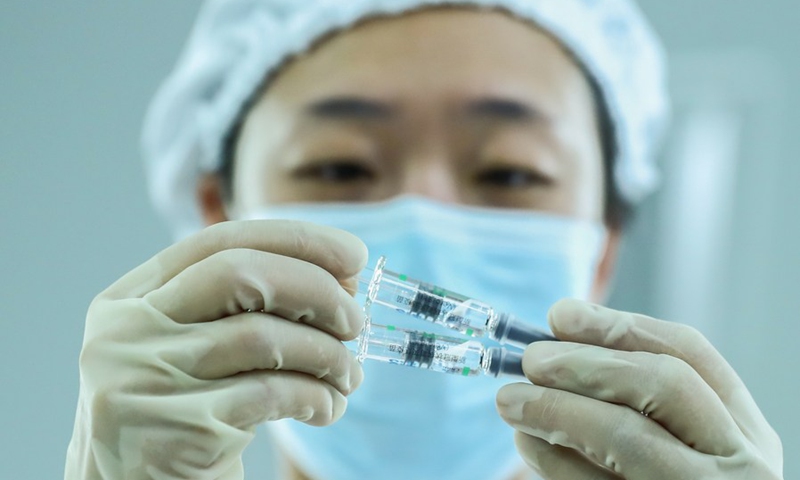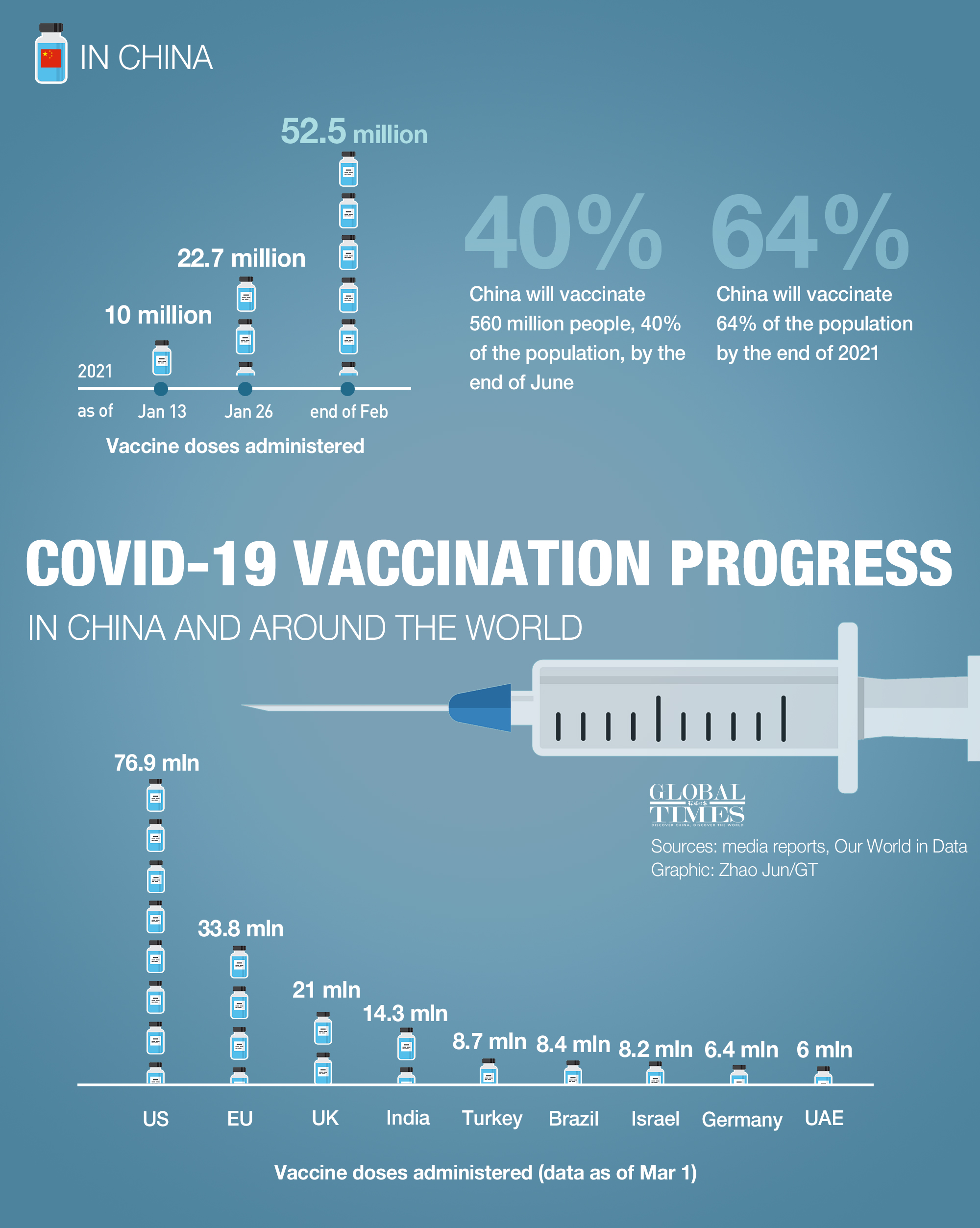
A staff member checks the packaging quality of COVID-19 inactivated vaccine products at a packaging plant of the Beijing Biological Products Institute Co., Ltd. in Beijing, capital of China, December 25, 2020. Photo: Xinhua
China is ramping up efforts to vaccinate 560 million people, or 40 percent of China's population, by the end of June, and another 330 million people will be vaccinated by the end of the year, covering 64 percent of the total population, the Global Times has learned.
Officials from regional branches of the Center for Disease Control and Prevention (CDC) across the country were summoned on March 2 via a televised meeting to prepare for the acceleration of mass inoculations with higher targets and faster rates, the Global Times learned.
Beijing has vaccinated nearly 6 million people with 8.7 million doses against the coronavirus as of March 10, Beijing local authority said, reaching nearly 30 percent of the local population, amid the accelerated national vaccination plan.
The accelerated vaccination campaign is aimed at catching up with the countries leading in vaccination rates as fast as possible to avoid an "immunization gap," according to a meeting summary viewed by the Global Times.
It is also meant to prevent possible outbreaks in spring and to safeguard a series of upcoming important events such as the Communist Party of China's centenary celebrations in July, international conferences and major sport events such as Asia Youth Games 2021 in November, and the 2022 Beijing Winter Olympics, the summary said.
Some provinces and municipalities in China, including Anhui and Shanghai, have set a target to vaccinate 40 to 50 percent of the population by the end of June, staff from local CDCs told the Global Times on March 2.
Their targets are part of the national vaccination plan, they said. China has a national population of 1.4 billion.
China's top medical advisor Zhong Nanshan said Monday that China aims to raise the domestic vaccination target to 40 percent by June. By the end of February, 52.5 million doses of COVID-19 vaccines had been administered, according to Zhong.
Currently China has a vaccination rate of 3.5 percent, far behind other big economies in forming herd immunity.
Considering the target to vaccinate 60-70 percent of the population to establish herd immunity, the current progress of the Chinese mainland's vaccination program is probably a little slow, Jin Dongyan, a professor at the School of Biomedical Sciences at the University of Hong Kong, told the Global Times in a previous interview.
"If some countries, where the epidemic used to be severe or vaccination proceeds fast, such as India and Israel, could reach herd immunity by the end of the year and resume international travel, I am afraid this will create an 'immunity gap' between the mainland and these places, pushing up the risk of imported cases to the mainland," Jin warned.
"Tight schedule, tough task, and much faster inoculation rate," read the meeting notes summarizing the new vaccination target.
All localities should set up adequate vaccination sites, medical staff, intensify vaccination training, and if necessary, set up temporary vaccination sites, reads the inoculation guidance in the notes.
"Financially, the vaccination costs are covered by local medical insurance funds, with subsidies from local public finance," said the notes.
Experts said China needs to speed up resource mobilization nationwide for the target.
Existing approved vaccine manufacturers are also expanding production capacity to meet the country's new targets.
Yin Weidong, CEO of Chinese vaccine producer Sinovac Biotech, told the Global Times in an exclusive interview on March 3 that the company is expanding its annual capacity to
2 billion doses by the end of June.
Production of the recently approved CanSinoBIO's vaccine is expected to reach 500 million doses in 2021. The manufacturer is building a factory in Shanghai to further boost capacity. Another leading producer Sinopharm claims it can guarantee manufacture of 1 billion doses in 2021.
CDC branches of Shanghai and Anhui told the Global Times that they have all been asked to accelerate the pace of vaccination. Even though this is a difficult target, there is confidence that the goal will be achieved, an Anhui CDC staff, who attended the provincial vaccination planning session on March 2, told the Global Times on condition of anonymity.
During a national planning session of the Chinese CDC on March 2, authorities clarified the vaccination goals for each province and assigned tasks to each region, said the employee.
A Shanghai CDC staff also said the city's vaccination program will be renewed to meet the new target.

COVID-19 vaccination progress in China and around the world. Infographic: GT
Experts said China's current moderate vaccination rate is partly because of a shortage of vaccine supplies and the lack of vaccination facilities.
However, China's leading infectious disease specialist and head of the Shanghai COVID-19 medical team Zhang Wenhong said he is not worried about production but rather about daily inoculation capacity. China's good epidemic control is also another reason for the currently moderate vaccination rate, he suggested on Monday.
According to the Anhui CDC staff, only 1.5 million doses have been administered to a population of more than 60 million in the province. The biggest challenge is the lack of vaccination sites and staff, which requires more investment and resource mobilization, especially in some areas where the vaccination campaign started late.
Insufficient domestic vaccine production could also be an obstacle, experts warned, considering that some batches have been ordered by other countries. However, expanded production lines in the next three months and possible vaccine imports may help fill up the gap, Tao Lina, a Shanghai-based vaccine observer, told the Global Times..
China's self-made COVID-19 protein subunit vaccine produced by Anhui Zhifei Longcom Biopharmaceutical Co, which is in late-stage trials in Uzbekistan and Pakistan, would be easier to mass produce once it is approved, and can help boost the number of doses.
The new target can be achieved if there is enough public education investment, such as community-based, tailored education to reassure the public about safety and their social responsibility to get inoculated, Yang Weizhong, dean of the school of population medicine and public health of Peking Union Medical College Hospital, told the Global Times.
Expanding the demographic groups of people that are eligible to be vaccinated as soon as possible is also a priority, he said.
Shanghai is expected to inoculate all people aged 60 and above with two doses of COVID-19 vaccine by the end of September for free. The measure aims to expand immunization of the population based on the national vaccination plan, the Global Times confirmed.
The move comes after
Beijing on Monday allowed people above 60 in good physical condition with the need for vaccines to have the jabs. Vaccination for minors under 18 will be carried out when trial results for this group are obtained.
In response to concerns over vaccine safety for seniors, Yin clarified that Phase II trial results on seniors are expected to come in March, and the company will submit the results to various countries' drug authorities for wider application.
Also,
Sinopharm on March 2 said it has completed clinical trials for groups aged 3-17 and will submit its data for approval soon, which industry observers said is likely to expand China's mass vaccination for minors.
If herd immunity is close to being achieved by the end of the year - 70 percent of the population - then it is likely that international travel restrictions that China has imposed can be lifted by then, Zhou Zijun, a professor at the Peking University's School of Public Health, told the Global Times on Wednesday. "But this is a multi-factor consideration, such as seasonal conditions that may vary disease-spreading levels."
Tao suggested that border opening should not depend on the vaccination rate of the population, but could be achieved by sharing traveler's vaccination records for green-light travel.





